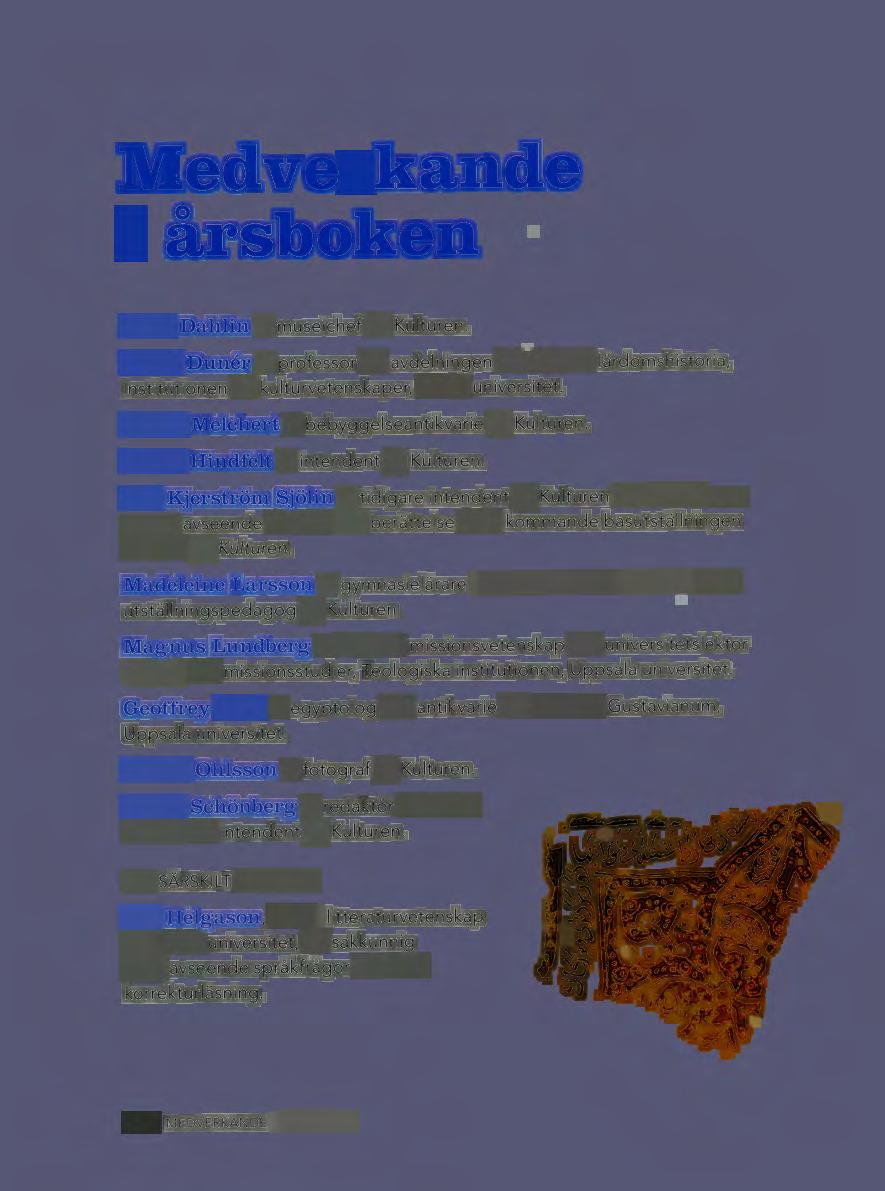
10 minute read
SUMMARIES IN ENGLISH
by Kulturen
Medverkande i årsboken
Anki Dahlin är museichef för Kulturen.
David Duner är professor vid avdelningen för ide- och lärdomshistoria, Institutionen för kulturvetenskaper, Lunds universitet.
Karin Hindfelt är intendent på Kulturen.
Eva Kjerström Sjölin är tidigare intendent på Kulturen och anlitad som expert avseende föremål och berättelse i den kommande basutställningen Världen på Kulturen.
Madeleine Larsson är gymnasielärare i historia och latin och före detta utställningspedagog på Kulturen. Magnus Lundberg är docent i missionsvetenskap och universitetslektor i kyrko- och missionsstudier, Teologiska institutionen, Uppsala universitet. Geoffrey Metz är egyptolog och antikvarie vid Museum Gustavianum, Uppsala universitet.

Viveca Ohlsson är fotograf på Kulturen.
Karin Schönberg är redaktör för denna årsbok och intendent på Kulturen.
ETT SÄRSKILT TACK TILL:
Jon Helgason, fil. dr i litteraturvetenskap vid Lunds universitet, för sakkunnig hjälp avseende språkfrågor och med korrekturläsning.
Summaries in English
in the interior of Asia, for example, became an important city for silk manufacture and was also a centre for Buddhism. Extensive reports sent home from China by Jesuits were to have an influence on Europe. Disciples of Linnaeus such as Carl Peter Thunberg were sent along on the ships of the Swedish East lndia Company. Scientific reports and literature also reached Sweden and libraries such as that of Bishop Thomander, preserved at Kulturen.

KARIN SCHÖNBERG
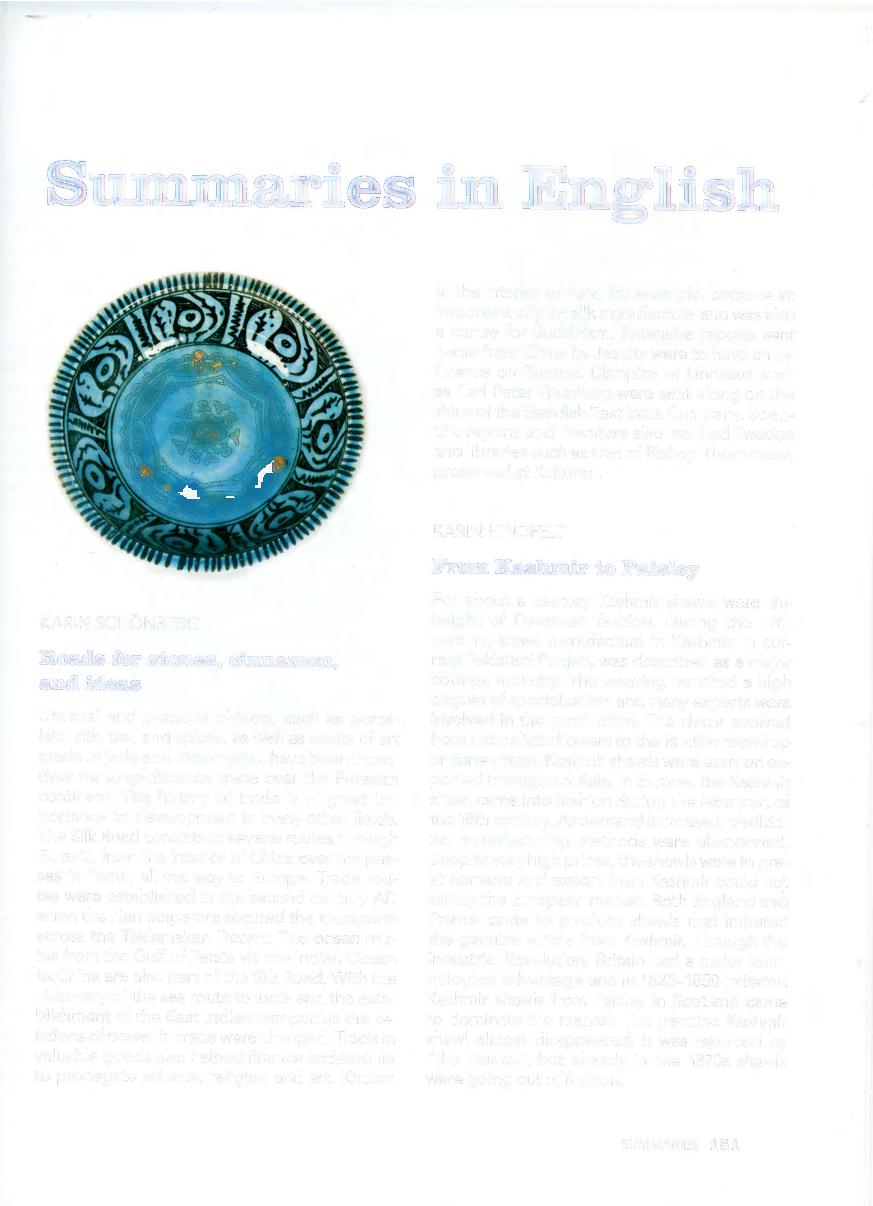
Roads for stones, cinnamon, and ideas
Unusual and precious objects, such as porcelain, silk, tea, and spices, as well as works of art made of jade and rock crystal, have been incentives for long-distance trade over the Eurasian continent. The history of trade is of great importance to development in many other fields. The Silk Road consists of several routes through Eurasia, from the interior of China over the passes in Pamir, all the way to Europe. Trade routes were established in the second century AD when the Han emperors secured the transports across the Taklamakan Desert. The ocean routes from the Gulf of Persia via the Indian Ocean to China are also part of the Silk Road. With the discovery of the sea route to lndia and the establishment of the East Indian companies the relations of power in trade were changed. Trade in valuable goods also helped finance endeavours to propagate science, religion and art. Khotan KARIN HINDFELT
From Kashmir to Paisley
For about a century Kashmir shawls were the height of European fashion. During the 17th century, shawl manufacture in Kashmir, in current Pakistani Punjab, was described as a major cottage industry. The weaving required a high degree of specialization and many experts were involved in the production. The decor evolved from naturalistic flowers to the familiar teardrop or cone shape. Kashmir shawls were early on exported throughout Asia. In Europe, the Kashmir shawl came into fashion during the later part of the 18th century. As demand increased, traditional manufacturing methods were abandoned. Despite very high prices, the shawls were in great demand and export from Kashmir could not satisfy the European market. Both England and France came to produce shawls that imitated the genuine article from Kashmir. Through the lndustrial Revolution, Britain had a major technological advantage and in 1825-1850 imitated Kashmir shawls from Paisley in Scotland came to dominate the market. The genuine Kashmir shawl almost disappeared, it was replaced by "the Paisley", but already in the 1870s shawls were going out of fashion.
EVA KJERSTRÖM SJÖLIN
Knowledge for sale

At the start of the eighteenth century the princely houses of Europe nourished an ardent desire to produce faience and other pottery within their own country. The ultimate dream was to make genuine porcelain, an invention of the Chinese, instead of having to import it from China. The man who finally succeeded in manufacturing "the white gold" was Augustus the Strong of Saxony. The first porcelain, fired in January 1708, was based on indigenous kaolin. In 1710 the first European porcelain factory was founded in Meissen. Those who knew the secret of porcelain making were called arcanists and their knowledge was highly valued. Despite great efforts to keep the technical know-how secret, two employees managed to escape. After just nine years a porcelain factory was founded in Vienna. The article describes the moves made by the most important craftsmen between different factories, and how these moves propagated the knowledge of porcelain pastes, glazes, and firing. In the mid-eighteenth century a great many porcelain factories emerged in Europe, and the art of faience was at its peak in Sweden and the countries around the Baltic Sea. CARITA MELCHERT
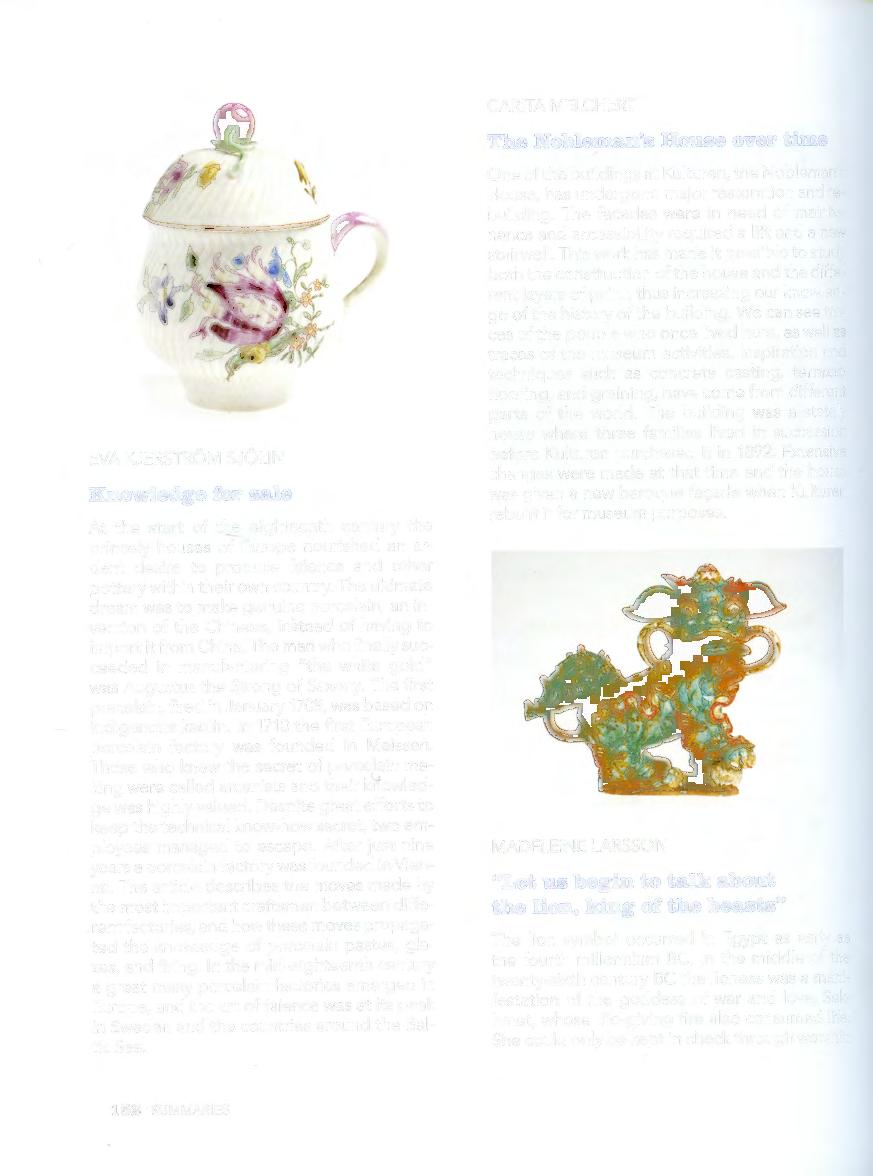
The Nobleman's House over time
One of the buildings at Kulturen, the Nobleman's House, has undergone major restoration andrebuilding. The facades were in need of maintenance and accessibility required a liftanda new stairwell. This work has made it possible to study both the construction of the house and the different layers of paint, thus increasing our knowledge of the history of the building. We can see traces of the people who once lived here, as well as traces of the museum activities. Inspiration and techniques such as concrete casting, terrazzo flooring, and graining, have come from different parts of the world. The building was a stately house where three families lived in succession before Kulturen purchased it in 1892. Extensive changes were made at that time and the house was given a new baroque fac;ade when Kulturen rebuilt it for museum purposes.
MADELEINE LARSSON
The lion symbol occurred in Egypt as early as the fourth millennium BC. In the middle of the twenty-sixth century BC the lioness was a manifestation of the goddess of war and love, Sekhmet, whose life-giving fire also consumed life. She could only be kept in check through worship
and rituals. In Mesopotamian culture the goddess lshtar appears in the form of a lion and also holds astrological significance. The great heroes in classical mythology were all compared to the lion. In a Christian context the lion symbolizes, on the one hand, Christ and on the other hand the devil. In the early modern era the lion symbol was secularized and often used as the king's symbol. The lion and its symbolism hasa dual nature which is both life-giving and destructive, both good and evil. Over time and place the lion has also symbolized a boundary between human and divine, between subject and ruler, between life and death.
DAVID DUNER
Voyage to Egypt

The Danish expedition to the Orient in the years 1761-1767 has, despite its many misfortunes, been remembered as one of the great achievements in the history of scientific expeditions. The destination was Yemen, but on the way there, a visit to Egypt was made in order to study hieroglyphs and buildings and to answer various questions. This was a search for the cradle of civilization and for biblical sites. The person responsible for the expedition and of linguistic issues was the Dane Frederik Christian von Haven. A disciple of Linnaeus, Peter Forsskål, was appointed as the naturalhistorian. The German Carsten Niebuhr was to draw maps, perform measurements and astronomical observations. The travelogues of Forsskål, Niebuhr, and von Haven give rare insight into the encounter of the West with the Orient. They struggled with adaptation, suspicion, and prejudice, but also tried to approach the extraneous and endeavoured to understand the other, which is best depicted in Niebuhr's account. Niebuhr's measurements using the astrolabe always attracted attention and caused unrest, but he tried to adapt to the customs and practices of the country, wearing Arabian clothes. As the members of the expedition died of malaria one by one, Niebuhr the physician was on his own and travelled by himself for four years. He returned in 1767, a changed man, with new knowledge anda new understanding of foreign people and their way of life.
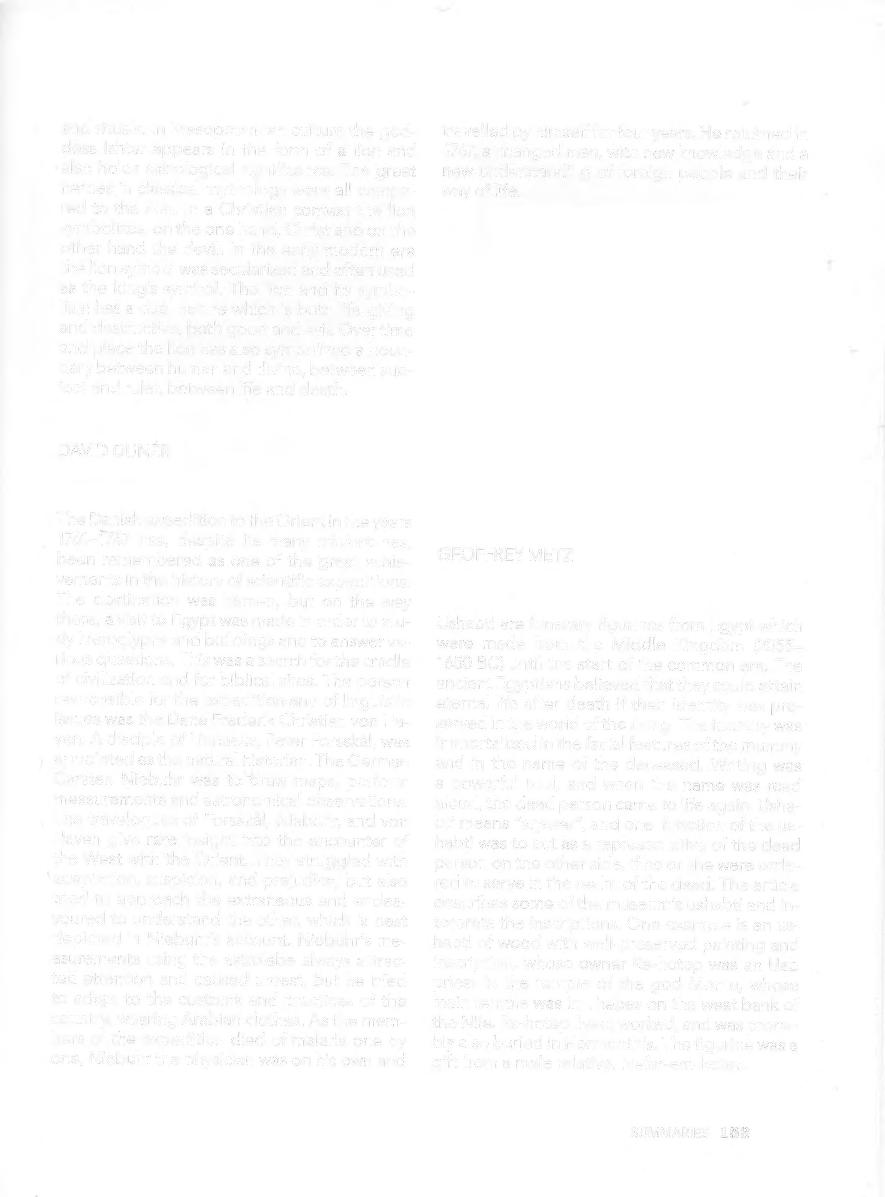

GEOFFREY METZ
Visiting cards from the other side
Ushabti are funerary figurines from Egypt which were made from the Middle Kingdom (20551650 BC) until the start of the common era. The ancient Egyptians believed that they could attain eternal life after death if their identity was preserved in the world of the living. The identity was immortalized in the facial features of the mummy and in the name of the deceased. Writing was a powerful tool, and when the name was read aloud, the dead person came to life again. Ushabti means "answer", and one function of the ushabti was to act as a representative of the dead person on the other side, if he or she were ordered to serve in the realm of the dead. The article describes some of the museum's ushabti and interprets the inscriptions. One example is an ushabti of wood with well-preserved painting and inscription, whose owner Ra-hotep was an Uab priest in the temple of the god Montu, whose main temple was in Thebes on the west bank of the Nile. Ra-hotep lived, worked, and was probably also buried in Hermonthis. The figurine was a gift from a male relative, Nefer-em-hotep.
EVA KJERSTRÖM SJÖLIN
The Japanese aesthetic and the tea ceremony
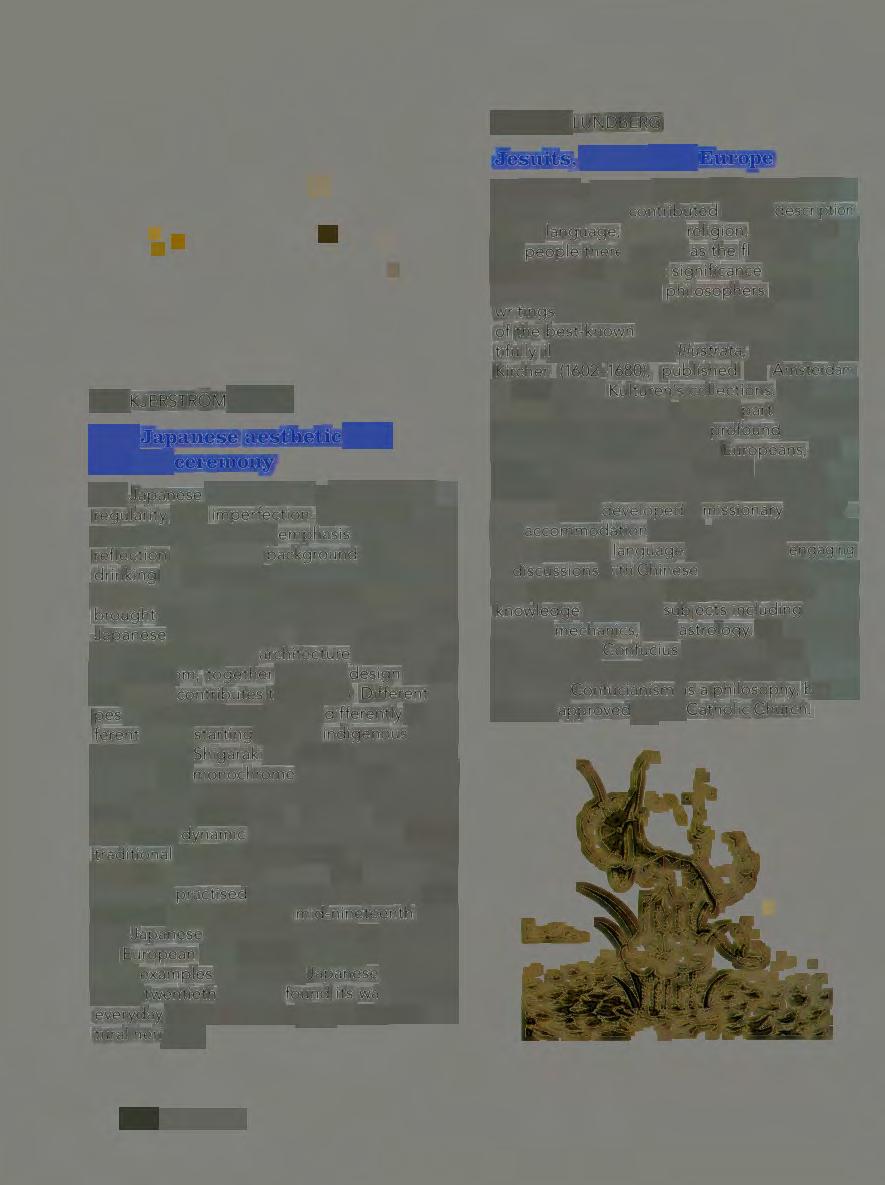
The Japanese aesthetic has a fondness for irregularity and imperfection. The Shinto reverence for nature and its emphasis of purity and reflection is a crucial background to this. Tea drinking in Japan can be traced back to the eighth century, when the Buddhist monk Eichu brought the custom from China. The aim of the Japanese tea ceremony is a focus on the inner and the present. The architecture and decor of the tea room, together with the design of the tea bowls, contributes to that aim. Different types of tea bowls were valued differently at different times, starting with the indigenous rustic pottery from Shigaraki and Bizen in the fifteenth century. The monochrome black or red glaze of raku ceramics suited the wabi style of the sixteenth century. Oribe ware is a form of stoneware with more dynamic forms and colours. Other traditional types of pottery were Hagi and Seto from the late sixteenth century. The styles of tea ceremony practised today go back to the Zen Buddhist style. From the mid-nineteenth century Japanese stoneware exerted an influence on European and Nordic potters. The article gives examples of how the Japanese aesthetic in the twentieth century found its way into our everyday life to become a part of our own cultural heritage. MAGNUS LUNDBERG
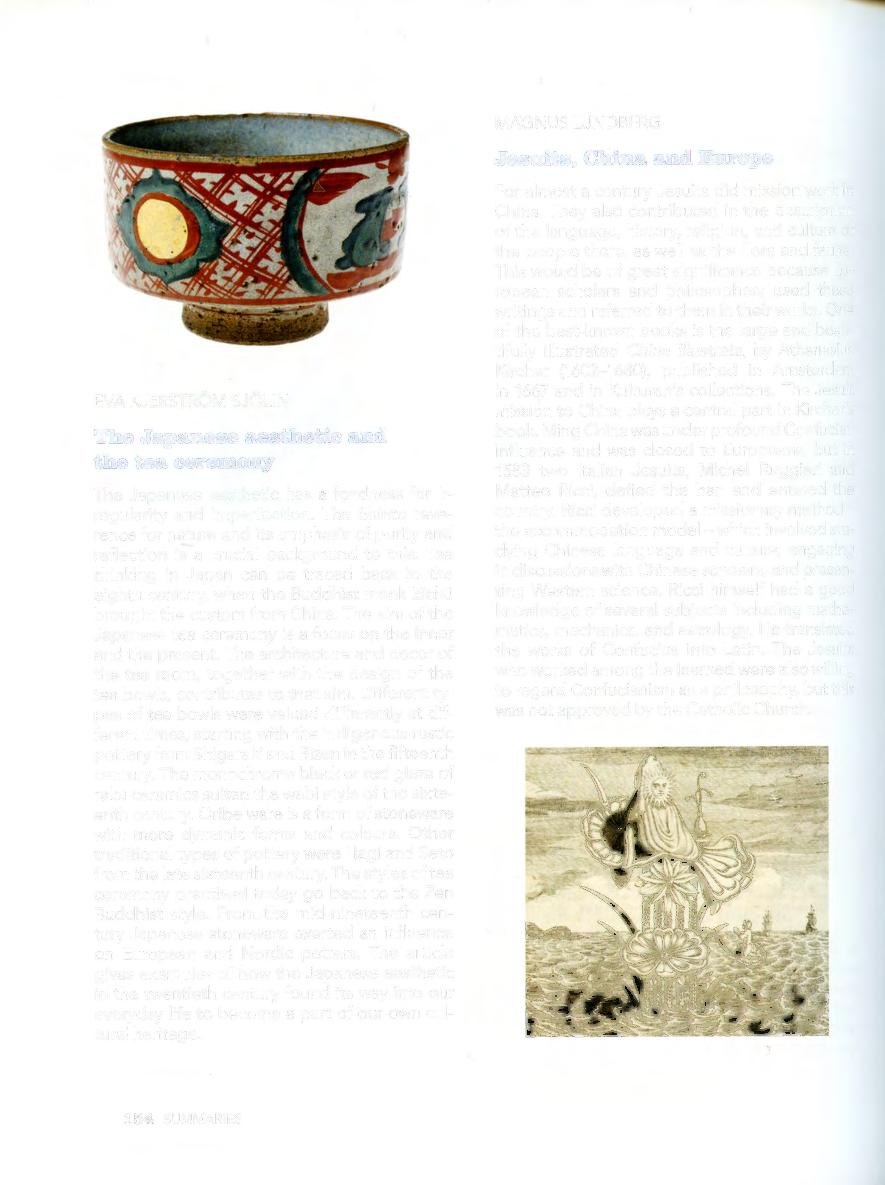
Jesuits, China and Europe
For almost a century Jesuits did mission work in China. They also contributed in the description of the language, history, religion, and culture of the people there, as well as the flora and fauna. This would be of great significance because European scholars and philosophers used these writings and referred to them in their works. One of the best-known books is the large and beautifully illustrated China //lustrata, by Athanasius Kircher (1602-1680), published in Amsterdam in 1667 and in Kulturen's collections. The Jesuit mission to China plays a central part in Kircher's book. Ming China was under profound Confucian influence and was closed to Europeans, but in 1583 two ltalian Jesuits, Michel Ruggieri and Matteo Ricci, defied the ban and entered the country. Ricci developed a missionary method the accommodation model - which involved studying Chinese language and culture, engaging in discussions with Chinese scholars, and presenting Western science. Ricci himself had a good knowledge of several subjects including mathematics, mechanics, and astrology. He translated the works of Confucius into Latin. The Jesuits who worked among the learned were also willing to regard Confucianism as a philosophy, but this was not approved by the Catholic Church.










